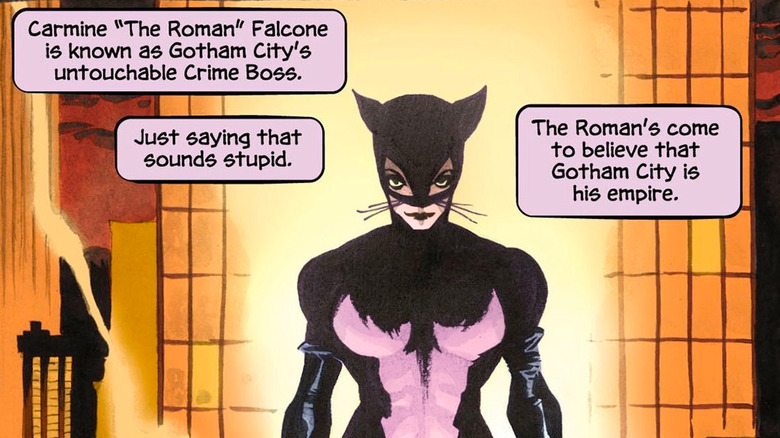The Catwoman Storyline The Batman Borrows Straight From The Comics
Warning: spoilers follow for "The Batman."
In the world of comic book adaptations, very few rely on just one source of inspiration. After all, many of the most iconic heroes have adventures that span decades. This truth couldn't apply better to our favorite late-night vigilante, Batman, who first debuted in 1939 — and Catwoman, who emerged soon after. The Princess of Plunder has enjoyed a number of adventures (and, it seems, as many backstories), which gave "The Batman" director Matt Reeves and star Zoë Kravitz plenty to pull from for the newest iteration of Selina Kyle.
Reeves has made clear that "The Batman" is a loose amalgamation of his favorite Batman storylines from the comics. "Those all inform by osmosis," Reeves said in 2018. "It's very much trying to find a way to do this as something that for me is going to be definitively Batman and new and cool."
That same goal extended to Catwoman — and Kravitz herself had a big hand in shaping her character's story. "When we met, I just knew that [Kravitz] thought so deeply about the character," Reeves recently said of the actress' process. "There were images literally from the comic books that she was like, 'God, if we could do this moment.'" Certain elements of the character — like Selina's close-cropped hair and her fondness for stray cats — have been lifted from "Batman: Year One," the celebrated comic that effectively rebooted the Dark Knight (and his impressive rogues gallery) in the late '80s.
"Year One" became the jump-off for Selina Kyle's definitive origins. The storyline helped endow the character with a fair amount of nuance and depth, and it also introduced a key figure in her mysterious origins: the mob boss Carmine Falcone.
Selina Kyle's comic origins
Carmine "The Roman" Falcone is a major player in "Batman: Year One." He and his family represent one of Batman's first major obstacles in shaking Gotham City from its yoke of corruption. Bruce Wayne's ties to the Falcones are further explored in "The Long Halloween," a 1996 series by Jeph Loeb and Tim Sale — but he's not the only one with connections to the crime family.
Selina's role in "Year One," "The Long Halloween," and its sequel "Dark Victory" seems peripheral at first glance. Her appearances are limited to her flirtationship with Bruce Wayne and equally flirtatious run-ins with Batman — usually when the latter is investigating Falcone. It turns out that Selina is less interested in Gotham's knight in Kevlar-plated armor than the crime boss himself, but it's not until "Dark Victory" that we learn exactly why.
Early in her tenure as Catwoman, Selina discovers that she may, actually, be the long-lost daughter of Carmine Falcone. While the Roman still lived in Italy, his wife Louisa gave birth to two daughters — which, according to mob boss standards, was just one too many. Falcone feared that having only daughters would weaken him in the eyes of rival families, so he conspired to have his second child killed.
Fortunately, Falcone's unwanted child was saved and later sent to America for adoption. Though Selina suspects that she was the child in question — and even travels to Rome to investigate her origins — the truth is never outright confirmed. In "The Long Halloween," Falcone is targeted and later killed by the serial killer known as Holiday, effectively shutting the case for good.
In the comic world, this origin doesn't sit well with everyone. It doesn't help that Selina's story has been rebooted twice since — but that's the beauty of an adaptation. It's all fair game for Reeves and Kravitz to borrow from. So how does all this translate to "The Batman"?
How The Batman adapts Selina's origins
The Batman films have usually split their focus between Jim Gordon's fight within the GCPD and Batman's battle with villains who share his enthusiasm for desperate measures. Though the crime families of Gotham appear often in the comics, they don't get as much time to shine in the adaptations.
Reeves remedies this in his interpretation of Gotham City. Carmine Falcone (John Turturro) is a major player in "The Batman." All roads lead to the Roman, and it seems that everyone — from the Gotham City police force, to the Penguin and even, at one point, the late Thomas Wayne — is in his pocket. Falcone frequents the Iceberg Lounge, as well as the club-within-the-club 44 Below. Kravitz's Selina works at the club, and her connection to Falcone also helps create her alter ego, Catwoman.
Though Selina tries to avoid 44 Below, she reveals to Batman that her mother used to work there. Maria Kyle was apparently close with Falcone, and knew he was the father of her child — a truth she shared with Selina before she was murdered. Though the identity of the killer remains unknown, Selina assumes her mother was strangled by "some creep from the club." Unfortunately, she has no idea how right she really is.
In helping Batman investigate the disappearance of her friend Annika, Selina learns (via haunting voicemail message) that Falcone murdered her to keep his secrets from leaking. Annika and Maria both died of asphyxiation, which retroactively pins Falcone as Maria's killer. It's no wonder Selina tries to dole out some vengeance herself later on.


